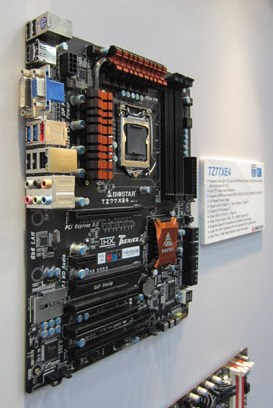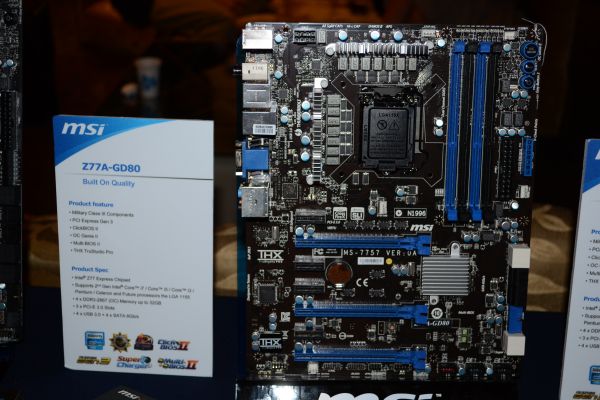A Brief Look at Some Upcoming 7-Series Motherboards
by Ian Cutress on March 9, 2012 5:00 PM EST- Posted in
- Motherboards
- Intel
- H77
- Z77
MSI
Whilst CeBIT is in full swing, MSI, along with the other manufacturers, has used the opportunity to showcase their future 7-series products. Alongside the X79 Big Bang-XPower II (which I recently reviewed and liked rather a lot), MSI is promoting their Z77A-GD80 – a 7-series motherboard with Thunderbolt support. Anand was able to have a quick look at the board at CES before the Thunderbolt port was officially added, and VR-Zone has confirmed that the model on show at CeBIT does have it on board. We expect this little extra will cause an extra $20-$30 on the price of these boards however, so it may be possible that there are Thunderbolt/non-Thunderbolt versions of various products up and down each vendor's line.
Out of the blocks, MSI is officially treating us to at least seven boards across the 7-series:
Z77A-GD80
Z77A-GD65
Z77A-GD55
Z77A-G45
Z77MA-G45
ZH77-G43
B75A-G43
MSI Z77A-GD80
In a style common of previous MSI boards, the blue-black livery is included with an SFC (Super Ferrite Choke) power delivery. We also get OC Genie buttons and voltage read points as is common on MSI's top end products. In a similar style to the Gigabyte Z77X-UD5H mentioned previously, users of three GPUs on a system such as this will perhaps lose a large amount of the functionality on the bottom of the board. Nevertheless, the USB 3.0 header on board is at 90 degrees, focusing the usage of such a port for the front of the case.
Biostar
Biostar is not a company we've had much chance to look at here at AnandTech for a while, however their few motherboard releases over the past year have come and are available for purchase. For the launch of the 7-series products, Biostar plan on launching a series of five boards:
TZ77XE4
TZ77XE3
TZ77A
TZ77B
TZ77MXE
However one motherboard has graced my inbox in any shape or form - the TZ77XE4:
Biostar TZ77EX4

Biostar have also gone with a three-GPU style setup, this time plumping for a three slot gap between all the GPUs, giving air for them to breathe a little better. Aside from this, there is not a lot I can gather from the solitary, low resolution image, and solid information is not forthcoming until I receive a response from Biostar. Information will be updated when I have it!
Conclusion
We have a lot to look forward to when it comes to these new and exciting 7-series motherboards. Let us know what you would like to see!














55 Comments
View All Comments
ComputerGuy2006 - Friday, March 9, 2012 - link
I like how both the ASUS P8Z77 WS and the ASUS P8Z77-V Deluxe have dual NIC. But without a hex core to go with these mobo's look like I am going to be stuck with my slow 1336 till ivy bridge-e....johnpombrio - Saturday, March 10, 2012 - link
Take a look at Anand's review of Ivy Bridge. He uses the SB- E as part of the benchmarking. It turns out that having those 6/12 cores and the extra cache did not make these expensive chips run most stuff any faster than the much less expensive IB. That decided me right there to upgrade to IB rather than to the SB -E chips. So Ivy Bridge with a Z77 chipset is the way to go unless you are doing some serious stuff with transcoding or double or triple SLI..euler007 - Sunday, March 11, 2012 - link
But people on the internets will have more cores than him!lunarx3dfx - Monday, March 12, 2012 - link
My 1366 920 is still hanging in there pretty good, and I was waiting on SB-E to upgrade, but I'm with John. The performance upgrade wasn't significant enough to justify the cost, so it looks like it'll be IB for me. Who cares about 6 or more cores if there isn't a huge performance gain?aguilpa1 - Monday, March 12, 2012 - link
I'm in the same boat, Don't let Intel know but there is usually one GRAND chip that can hold its own against several generations of mediocre chips before an upgrade is needed. The i7 920 when OC'ed is one and the Q6600 was the one before that. I had both and now I'm on the 920 and there doesn't seem to be a good reason to upgrade until IB.Samus - Tuesday, March 13, 2012 - link
I've had an Asus x58 chipset board with a i7-950 for over 3 years, I have upgraded nothing. It is still faster than 90% of the computers on the market, and within 20% of the performance of mainstream Sandy/Ivy Bridge chips.There is no compelling reason to upgrade to Socket 1155 from Socket 1366. I agree with john and lunar in waiting for the next socket/architecture.
Intel really outdid themselves with Bloomfield.
adece - Friday, March 9, 2012 - link
Unless Gygabyte or ASRock puts WiFi on a sub $220 Mobo of their's, my money is going to Asus.deltatux - Friday, March 9, 2012 - link
It would have been nice if ASUS or GIGABYTE would put at least one or two PCI slots. There are still a lot of sound cards and TV tuners that are mainly PCI.It would definitely suck if I am forced to upgrade my sound card which works perfectly just because new motherboards force users to upgrade even though the majority is still on the older tech.
Don't get me wrong, PCI is long overdue to get replaced but honestly, there's still too many of these expansion cards which are still reliant on the older PCI bus.
Concillian - Friday, March 9, 2012 - link
Several Z68 / P67 mobos have PCI slots, will support IB, and should be available for a while.The Z77 chipset has no PCI outputs. It's a little unfair to blame the motherboard makers for not including a feature that is not in the base chipset. It can't be simple to just slap a PCI slot on a mobo with a chipset that is designed not to use them.
DanNeely - Friday, March 9, 2012 - link
Theoretically they could use a PCIe-PCI bridge chip to add a legacy slot; but the cost of doing so (to include the engineering work to integrate it) would probably exceed that of buying a higher end chip from Intel.